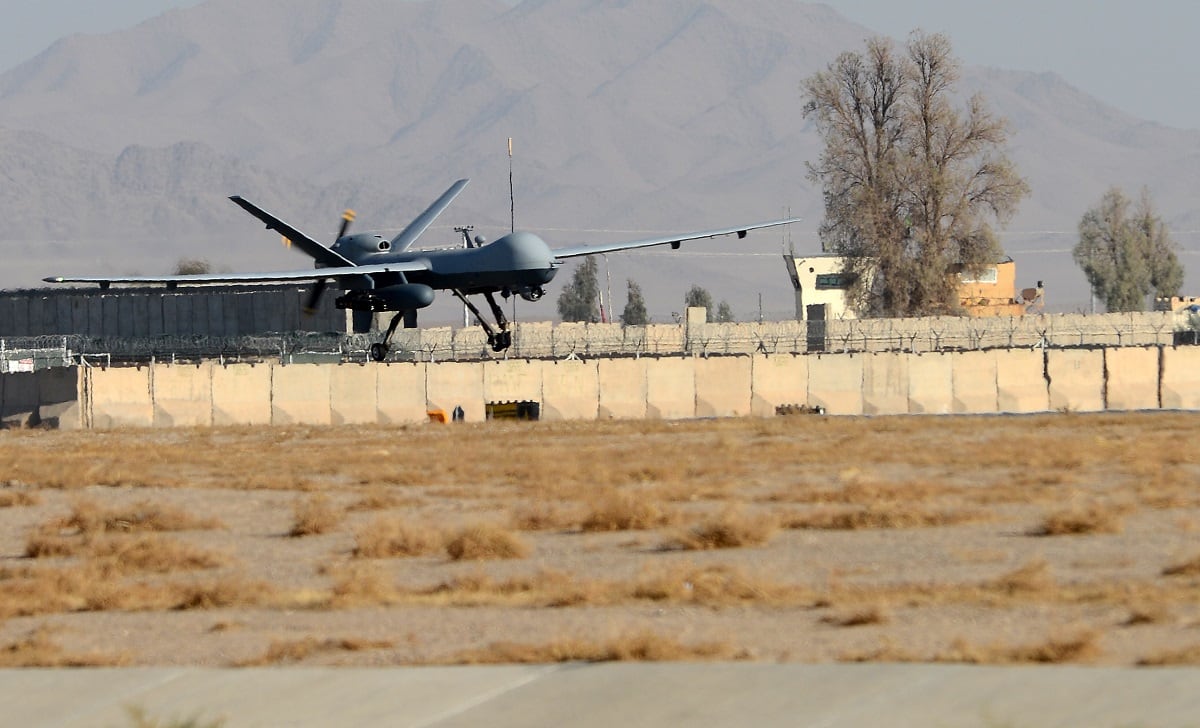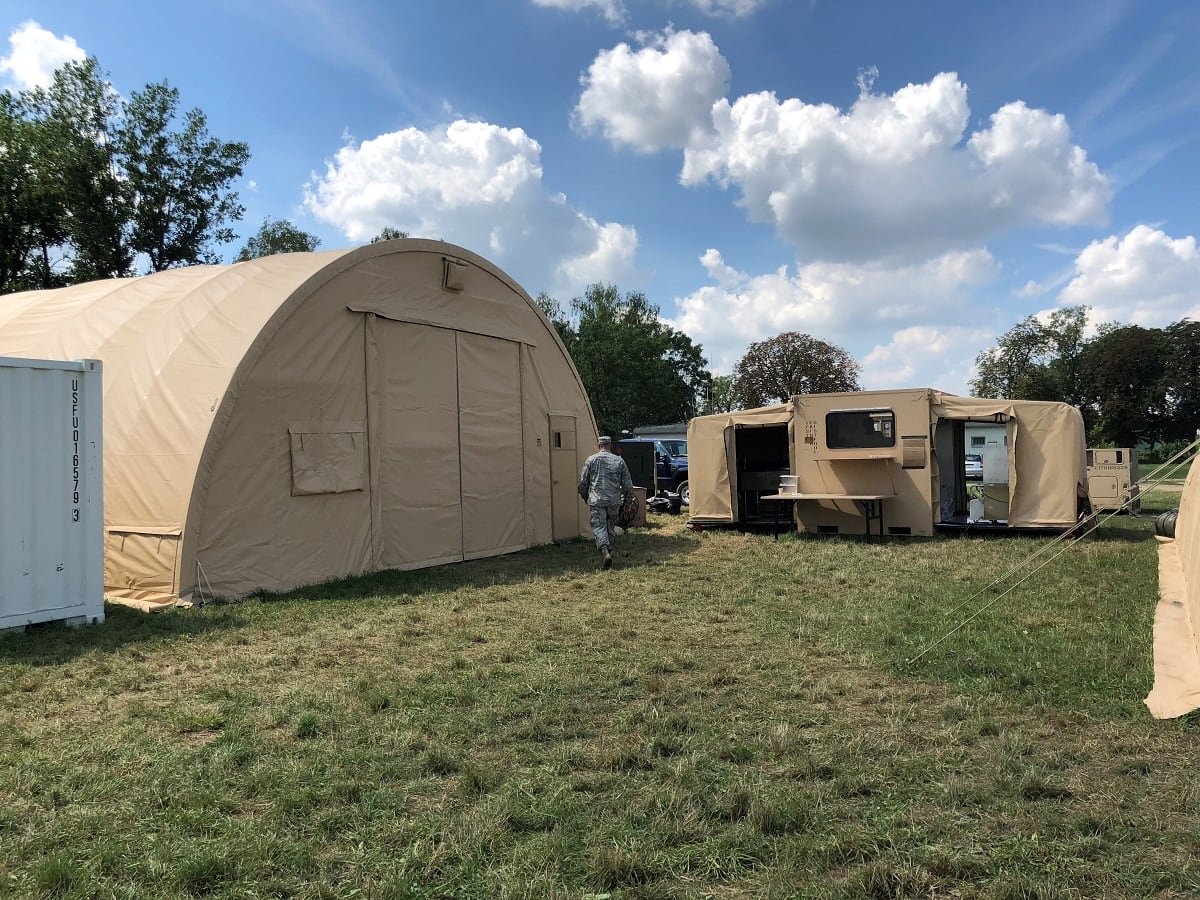KRZESINY, Poland — When Brig. Gen. Roy Agustin first took the job of director of logistics, engineering and force protection in 2015 for U.S. Air Forces in Europe and Air Forces Africa, the service had a handful of major operating bases in western Europe.
But as the Air Force has ramped up training and exercises in the region in response to growing Russian aggression, it has also increased its level of investments in military construction and pre-positioned equipment that would enable the service to deploy to eastern Europe if necessary.
In fiscal 2019, the service will begin buying deployable air base systems, or DABS — a collection of shelters, vehicles, construction equipment and other gear that can be pre-positioned around the globe and moved to any place the Air Force needs to stand up air operations.
Agustin sat down with Defense News on July 31 at Poland’s 31st Air Base, the site of the first DABS proof-of-concept exercise held from July 16 to Aug. 14, to explain why the systems are so necessary to how the Air Force could operate in the future.
What was EUSAFE seeing in this region, threatwise, that prompted it to procure and deploy with the DABS systems?
With the deployable air base system, it is not designed just for one area. It allows us to look 360 degrees from across our 104-nation theater because in USAFE we do United States Air Forces Europe and Africa. The reason we chose Poland was because of the strong bilateral relationship we have. We have in the past and continue to invest [in Poland] first with European Reassurance Initiative dollars, now called European Deterrence Initiative, where we are jointly improving airfield capabilities to enable both Polish and our forces to operate together.
So when we looked at what would be challenging from a logistics standpoint, where most of our war reserve materiel is to the West — in either Luxembourg, Germany or the U.K. — we wanted to test ourselves. So from that area to here was 1,000 kilometers.
From Luxembourg to here?
From Luxembourg and Germany to here. We wanted to also see how we could do a multi-modal deployment, meaning not just by airlift with C-130s, which we did have, but also to see how we could use commercial trucks and how we could use commercial trains. Many of our airmen have not worked with trains. So we had a 16-rail-car train loaded up in one day, and in the very next day delivered here. [Editor’s note: The train was 19 cars.]
RELATED

Some people might talk about Harvest Eagle [deployable equipment sets] out in New Mexico. In a crisis, to ship from New Mexico to here in a quick, fast way for the same amount of assets would take 100 C-17s for one deployable air base system. Here, you leverage the rail cars, the trucks and a few airlift items that would get things here quicker. So what took us, for example, 120-plus days as we shipped from Holloman Air [Force] Base in New Mexico to this theater now is, in one day, from Sanem, Poland, to here.

Could it have been Sanem to Norway, Sanem to the south in Greece? Certainly. But because of, again, this long-standing relationship, we have an aviation detachment that’s been here a while with an aviation rotation with the C-130s and the F-16s. We have a perfect partner and host with Poland, and that’s why we chose Poland.
It seems like the Air Force is moving to a more disaggregated and distributed way of operating in this theater. Why is that a good and necessary thing, especially with this new National Defense Strategy?
When you talk about distributed, the other way you could talk about it is dispersed. I first came in the Air Force with 30 main operating bases here in this theater, with probably double the amount of blue-suit personnel [and] triple the amount of aircraft. So when you hear, from the recent NATO summit, when you talk about the “four 30s,” [that’s] 30 squadrons, 30 surface ships, 30 brigades in 30 days.
I just mentioned to you 120 days from Holloman to here to ship all that equipment. Now you can have that equipment pre-positioned here, disperse it out from the few main operating bases that we currently have, and put a squadron dispersed. You gain resiliency, you gain agility of operations and greater coverage by spreading your war-fighting capabilities throughout.
And you show the allies, too, that you’re here with them in whatever crisis that they face. “We are here with you and we will be here with you, and we’ll be here quickly with those assets.”
You mentioned Harvest Eagle, but there are a lot of existing Air Force expeditionary capabilities like RED HORSE and Prime BEEF engineering squadrons who are participating in this exercise. Will that also happen when an actual, full-up DABS is deployed, or was that just a feature of this demo?
I think it’s a feature of our total force. Of the 55 or so people here right now, they come from eight Guard units, one Reserve unit and a mix of other active-duty units. But the majority of them came from Peoria, Illinois.
Over half of the team here are from Peoria, but you also have from Memphis, Tennessee, from Ohio, from Montana, etc. It’s an amazing feat that we can take these individuals from separate units, put them here, meld them together and they operate as one team.
RELATED

And the equipment, with their training, they are able to set this up like that. And you talk about Harvest Eagle and Harvest Falcon — those assets were there when I first joined the Air Force. Just the generators ... sitting outside this door [are] 50 percent more fuel-efficient, double the capability. So in the past the one generator could support two tents and one fuel load would last eight hours. This one new generator supports four tents and then lasts 12 hours. So rather than do three fuel deliveries a day, you do two, and you reduce your footprint. That’s just one example. You [can] replicate this across the board with the lighting systems, the shower/shave unit.
When we deploy forward, we have very generous hosts, but in a crisis they are going to need their capabilities for their priorities and their mission sets, and we’re going to fight jointly and operate jointly. But rather than add a burden by, “Hey, can you provide us power, can you provide us lodging?” — if we can bring that organic capability with us, we are both more capable and there is more synergy as a result.
What are the major lessons learned from this exercise?
When I first got here three years ago in USAFE — this is my second tour in this theater — I really admired watching how the Army’s first rotation of their armored BCT [brigade combat team] came in and the lessons learned they had there.
And it’s all about process. What do you put on the first truck? What is in which container and having that in-transit visibility so that you know that particular tent or that particular comm equipment is on that aircraft or that rail car, because it matters.
It all comes down to the details.
Right. Because if you open up one container, for example, but the instructions [aren’t in there], we just had that here. The instructions were with one of the tents, but if you don’t open that up first, some of our younger troops may not have seen or experienced [putting] it [together].
Luckily, we also have electronic ways of getting those technical orders. But say we’re in a more austere environment where we couldn’t hook up to Wi-Fi or the internet and we couldn’t get those technical orders electronically, then that might be more of a challenge.
One of the things we’re going to bring back to our team is, “Hey, put the technical order on each container.” Just as a stopgap. Just in case.
Some other lessons learned — those generators. I want more of those [new] generators versus the [less capable] 805s next to it, because it cuts down on the fuel, cuts down on the servicing, cuts down on how many generators we need. And thus, less trucks you need to transport them or less aircraft. That would be a good thing.
Image 1 of 10
Also, where can the host nation have some capability that we can leverage? We’ve been eating breakfast at the Polish DFAC [dining facility]. Now that’s new — a lot of our airmen have never visited Poland before, and this is a great cultural experience. But then we didn’t have to have DLA [the Defense Logistics Agency] ship us that food because we leveraged our Polish hosts.
How might DABS be used over the next few years, outside of a major conflict?
I see it more as the ability to be more agile in our basing.
Being able to look 360 degrees ... there [is] some additional stability we can add by putting our forces forward quicker, collocated with our allies and our partner nations, and we can do that whether it be a humanitarian crisis or a more kinetic type of threat. Being there with our allies is a good thing.
Have you decided the next step for testing DABS? Could you use it to support a theater security package of combat aircraft, and do you think that becomes the new norm?
It could. I think, as you know, the TSP operate from our host nation allies’ air bases, and leveraging those capabilities. But if we wanted to be in a more austere location, I think DABS would definitely be something that we could employ more readily. And we can augment to where if they don’t have aerospace ground equipment or even food trucks. We could pull things from a DABS to fill in those gaps at a particular location.
Has there been a decision on the next exercise or how to push this forward?
We were just talking about that. DABS was first funded in FY18, so it’s still in the procurement phase. So as we get more of these equipment delivered, as they are bought by Air Force Materiel Command and then they are delivered, I think we certainly want to see if we can deploy and employ even a greater part of that capability.
Does supporting drones or fifth-generation fighters fit into the DABS construct at all?
It can support any flying mission, so yes. The straight answer is yes. But you probably wouldn’t have to bring as much of the aerospace ground equipment, for example, because you wouldn’t need as much of that to support, let’s say, an MQ-9 [Reaper]. It would be a smaller footprint versus, say, an F-14 and F-15s — they might take a little more.
And then definitely if you’re supporting a squadron of tankers, you’re going to need more R-11 refuelers, where you might not need that with fighters. So that gives us that tailorable type of capability.
Valerie Insinna is Defense News' air warfare reporter. She previously worked the Navy/congressional beats for Defense Daily, which followed almost three years as a staff writer for National Defense Magazine. Prior to that, she worked as an editorial assistant for the Tokyo Shimbun’s Washington bureau.
















